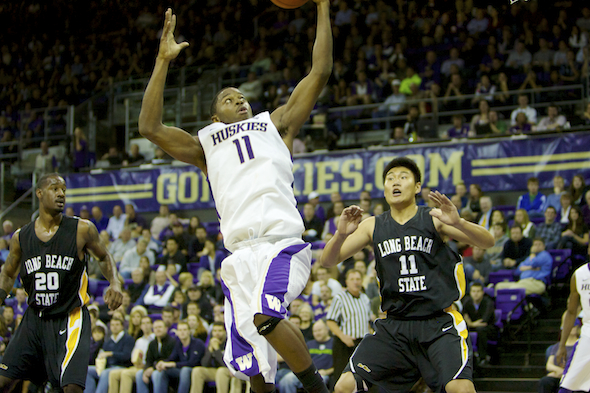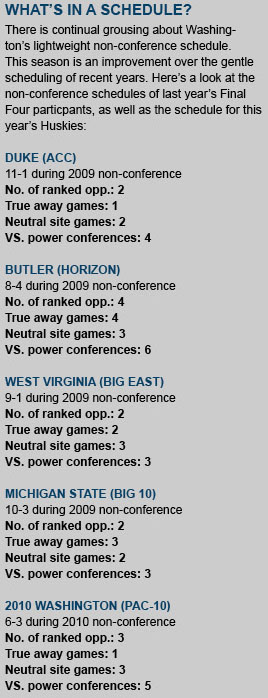
Despite the current economic climate, Washington’s traditional non-conference schedule is capable of obtaining a natural sponsor.
Perhaps a maker of nice 300-thread count sheets. A producer of gentle towels. Something warm, cuddly, soft.
The lack of prime opponents is a grumble starter every holiday season. Washington fans want to know when Lorenzo Romar is going to trade the pastries for beef.
This year has been an improvement. Three ranked teams, two in the top 10 at the time, have elevated quick analysis of Washington’s non-conference schedule.
The previous season wasn’t the sack-over-the-head level of scheduling many portrayed it as. The Huskies played two teams that were ranked, three that went to the tournament, and three mid-majors that won 19 or more games.
But the Washington non-conference schedule remains a common gripe and a top issue when rationalizing lack of NCAA tournament success (though three Sweet 16s in six years doesn’t qualify as that).
Gonzaga’s scheduling exacerbates the thought line about Washington’s paltry opposition. The cross-staters load up with Michigan State, Duke and other big wigs. Those opponents are necessary for Gonzaga to maintain its national profile considering how inept the West Coast Conference is.
Michigan State is renowned for diabolical scheduling despite a difficult conference. This is the rarity.
Most power programs turn away from chances to frontload the schedule. Not Spartans head coach Tom Izzo.
“I played John Chaney and Temple, my second year,” Izzo said. “Then we went there and (he) beat us (again), both by one I think. He was a guy that would play anybody, any place, any time.
“I always thought I had great respect for that and saw what it did for his program, the toughness it brought. So, I just started doing it. And then started having success, so why quit?”
The reasoning for Gonzaga and Michigan State has slight variation. Izzo grows his team through year-long battles. Gonzaga head coach Mark Few gets in the ring early in order to reference it late. It has worked for each.
Though a bond between the programs this year is taking early lumps. Both Few and Izzo told Sportspress Northwest they were concerned about the non-conference schedule. Few so much so that he was already preparing to back off next season. The Zags are 4-5 with little relief ahead prior to conference play. They still play No. 9 Baylor, perennial tournament participant Xavier, Oklahoma State and Wake Forest.
 Michigan State is 7-3, with three losses to teams in this week’s top 10 (No. 1 Duke, No. 4 UConn and No. 5 Syracuse). The Spartans play three neutral site games, one road game and six games against major conference opponents over the 12 they play prior to a loaded Big 10 schedule. Almost half their opponents this season will be ranked.
Michigan State is 7-3, with three losses to teams in this week’s top 10 (No. 1 Duke, No. 4 UConn and No. 5 Syracuse). The Spartans play three neutral site games, one road game and six games against major conference opponents over the 12 they play prior to a loaded Big 10 schedule. Almost half their opponents this season will be ranked.
To contrast, Washington played three teams in this week’s top 25 (No. 14 Michigan State, No. 17 Kentucky and No. 25 Texas A&M), all losses. The Huskies play three games on neutral courts, one on the road and five against major conference opponents in the non-conference 11. Top-ranked Duke plays two ranked opponents, four neutral site games, one true road game (at UNC Greensboro, which will be swamped with Duke fans) and five teams from power conferences among its 13 “preseason” opponents.
For coaches of major programs, non-conference scheduling is a balance. Actual time and geographical considerations are countered by politics (see Washington vs. Gonzaga). More often, it’s wrangling with competition versus confidence. That concerns Izzo.
“I kind of waver on that once in a while because I think that competition is important,” Izzo said. “But the way that social media is now, the way everything is now … talk radio … kids can really get hammered.”
Same issue for Connecticut’s Jim Calhoun.
“The only thing you don’t want to do is you don’t want to take away your team’s confidence,” Calhoun said. “That’s the thing you get worried about. But we need to find out who we are, what we are. They’ve got to understand what they’ve been playing against (prior to tougher opponents) is not what they’ll be playing against the rest of the season.”
Another layer is intangible: support from the administration and boosters.
Typically viewed as a football topic, it’s applicable in basketball. Will the athletic director and his cash cronies tolerate an 8-4 to start the season? Or do they want the braggadocio that comes with 11-1 after numerous bum whackings?
“You don’t want to schedule yourself into not having a job,” Illinois coach Bruce Weber said. “But at the same time you want to play as many venues that will give you that feel. You want to play as many teams all over the country, different styles to prepare your guys not only for your league and going on the road, but also for the NCAA.”
The recent decline of the Pac-10, the pending variation of conference play because of expansion, and end of the Big 12/Pac-10 Hardwood Series leaves Washington with future scheduling conundrums. Romar said the Huskies will attempt to replace Texas Tech and Texas A&M, opponents of the past two years, with other high-level opposition. The Huskies have two non-conference games remaining this year, both against kowtowing opposition.
Pac-10 coaches argue teams in the league will be better by February. It’s true. Problem is, perception has been established and the conference’s reputation has again been flushed. No team is more responsible for that than Washington, the assumed favorite that has lost against each difficult opponent. That leaves any early 2011 progress unquantifiable for those outside the conference, many of whom influence NCAA tournament invites.
Washington has started lousy and made it to the Sweet 16. It started well and made it to the Sweet 16. It is yet to test early season work loaded with bear traps. In order for the Huskies to step into the next tier, that needs to be done soon.

2 Comments
I had the same complaint the past few years, but not this year. The reality is UW is not yet at the level of those other programs yet. They are getting closer, as evidence by the games against top 25 teams. They aren’t at a level they can up the competition level and afford to take those losses on their record. Still need the wins to assure getting into the tourney or be forced to rely on the winning the pac-10 tourney like last year. The football team has exactly the opposite problem, getting killed by top level teams each year in non-conf games only helps keep you out of bowl games until the program is more competitive. FB is trying to schedule a softer non-conf schedule while they rebuild. The key is getting to the Big Dance and going deep in the tourney, not wins early in the season.